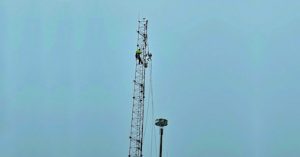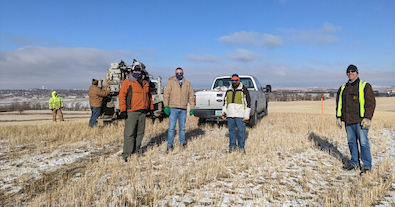The Northern Plains Unmanned Aircraft System (UAS) Test Site (NPUASTS) is close to completing installation of remote surveillance and communications infrastructure, says a NPUASTS press release. Vantis, North Dakota’s statewide UAS network is gearing up for testing and validation of the network in line with the rigorous safety measures required by the industry and Federal Aviation Administration (FAA).
The Northern Plains UAS Test Site (NPUASTS), which administers Vantis, has worked closely with the FAA to plan testing procedures that are safe, do not interfere with existing manned aviation in the region, and which will prove the safety and reliability of Vantis moving forward.
Installation of Vantis infrastructure includes radars, ADS-B receivers, and command and control radios; all of which will allow an unmanned aircraft system (UAS), or drone, pilot to electronically “see” from the perspective of the UAS, as good or better than a pilot in a manned aircraft using their eyes. This will allow UAS to fly safely beyond visual line of sight (BVLOS) of the pilot. This technology has been successfully installed at the Williston Basin International Airport and on North Dakota Department of Transportation (NDDOT) towers in Williston and Arnegard, ND. In-progress installations include Watford City Municipal Airport as well as commercial cell tower sites near Keene, ND. The technology that enables Vantis also includes a Mission and Network Operations Center (MNOC), located at Grand Sky business and aviation park in Grand Forks County.
With Vantis’ remote infrastructure linked to the MNOC, Vantis is “connected,” and ready to undergo multiple levels of testing to ensure safety and reliability. Development flight testing begins in May and involves testing the installed technology to make sure that individual pieces are working, and that all these pieces are working together the way they should be. Lab testing is ongoing at L3Harris and Thales USA facilities, and will transition into flying both manned aircraft, through Overland Aviation, and unmanned aircraft, through Volansi, to complete verification and validation of the aircraft and network components. Operational testing will follow during the summer once the system has been accepted. This will involve actual UAS flights using Vantis to emulate use cases such as pipeline and road inspections. UAS will be accompanied by manned aircraft flying in proximity to ensure safe integration of the flight operations and Vantis procedures.
All of this is facilitated through extensive work with the FAA. In addition to the visual line of sight (VLOS) testing Certificates of Waiver or Authorization (COA), a Federal Aviation Regulation (FAR) 91.113 waiver request for BVLOS flights on Vantis has been submitted. The data collected and the safety assurance provided through validation and testing efforts throughout the summer will be used to support this waiver request, providing a clear, fact-based safety case for FAA approval of flights on Vantis.
“Safety is always our number one priority,” said Trevor Woods, director of safety for NPUASTS and Vantis. “Vantis is blazing a new trail in UAS operations, and we take that responsibility very seriously.”
“We work closely with the FAA on every step of this process,” says Nicholas Flom, executive director of NPUASTS and Vantis. “It’s an ideal partnership because we have a shared goal of achieving BVLOS flights that are scalable, repeatable, and economically viable.”

(Images: NPUASTS)
For more information visit:




